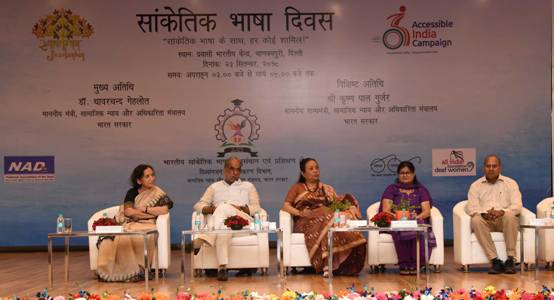DEPwD Celebrates ‘International Day of Sign Languages’
New Delhi: “International Day of Sign Languages” was celebrated by Indian Sign Language Research and Training Centre (ISLRTC) under Department of Empowerment of Persons with Disabilities (Divyangjan), Ministry of Social Justice and Empowerment here today. Shri Krishan Pal Gurjar, Minister of State for Social Justice and Empowerment was the Chief Guest on the occasion. Smt. Shakuntala D. Gamlin, Secretary, DEPwD, Smt. Dolly Chakravarty, Joint Secretary & Director, ISLRTC and many Deaf and Dumb persons along with their families were present. A special calendar of year 2019 with Sign Languages designed by ISLRTC was released on the occasion.
Addressing on the occasion, Shri Krishan Pal Gurjar congratulated all Deaf and Dumb persons on the International Day of Sign Languages and said the Union Government is committed to the welfare of Divyangjan and many important steps have been taken during past 4 years. He said that his ministry has written to all ministries to make special provision for Sign language interpreter in all their functions and programmes so that the deaf and dumb persons may also get benefitted. He said that Sign language is a powerful visual language which can revolutionize deaf education and develop qualified human resources.
International Day of Sign Languages is celebrated annually across the world on 23 September every year along with International Week of the Deaf. The choice of 23 September is the same date that the WFD was established in 1951. The theme of International Day of Sign Languages is “With Sign Language, Everyone is Included !” With Sign Language, Everyone is Included! IDSL held today, along with IWDeaf, which runs between Monday, September 24 and Sunday, September 30, 2018.
Sign language has been used for over centuries. The language capabilities of deaf children who use sign language are better. There is no advantage to delaying exposure to sign language, and research on the development of language has found that early exposure reduces the risks of language development. Lot of intensive therapy is needed after CI, even then the success is not guaranteed.
Earlier the schools focused on the oral education. However, now the educators and policy makers have gradually started bilingual schooling which is considered ideal for the deaf children as they acquire sign language as first language and are taught other spoken language through first language. This helps in enhancing their literacy skills. A child can express anything through sign language because it is a natural language. Each deaf child is different therefore one type of education may not be fit for all. A deaf child can have a CIAND use sign language simultaneously.
The longer a person waits, the more his child’s brain has to deal with the harmful effects of language loss. Sign languages are complex grammatical languages just like the spoken ones. They have their own grammar and vocabulary. No one form of sign language is universal. Different sign languages are used in different countries or regions. For example, British Sign Language (BSL) is a different language from ASL, and Americans who know ASL may not understand BSL.

